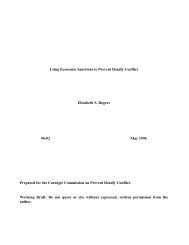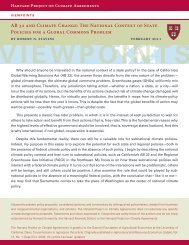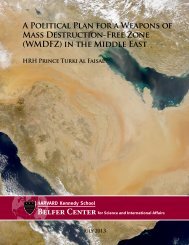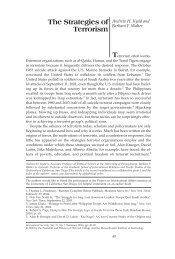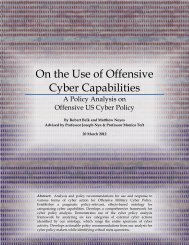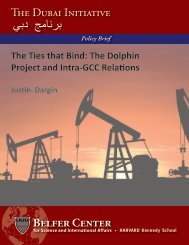Plutonium Mountain - Belfer Center for Science and International ...
Plutonium Mountain - Belfer Center for Science and International ...
Plutonium Mountain - Belfer Center for Science and International ...
- No tags were found...
Create successful ePaper yourself
Turn your PDF publications into a flip-book with our unique Google optimized e-Paper software.
the hundreds of sensors <strong>and</strong> other pieces of equipment that will eventually need to be replaced—<br />
is questionable, especially given the fact that Kazakhstan’s nuclear regulators remain relatively<br />
weak, <strong>and</strong> funding <strong>for</strong> the site is limited. But U.S. officials say that the cementing of the tunnels<br />
provides enough of a barrier so that even a basic monitoring system should suffice.<br />
The security at Degelen <strong>Mountain</strong> raises an uncom<strong>for</strong>table reminder, however, of just how difficult<br />
it will be to sustain an effective security operation at Semipalatinsk <strong>for</strong> the duration that<br />
will be required. <strong>Plutonium</strong>’s half-life is 24,110 years. 91 The plutonium at Degelen <strong>Mountain</strong> will<br />
potentially pose a danger <strong>for</strong> a time frame beyond human underst<strong>and</strong>ing. It is certainly true, as<br />
the plaque at Degelen <strong>Mountain</strong> attests, that the world has become safer than it was be<strong>for</strong>e the<br />
operation, but it also remains the case that the scars left by nuclear weapons testing during the<br />
Cold War will last <strong>for</strong> eons. Asked at the picnic when it will be possible <strong>for</strong> security to be withdrawn<br />
from Semipalatinsk, Sergei Lukashenko, the director of Kazakhstan’s Institute of Radiation<br />
Safety <strong>and</strong> Ecology, ignored his Russian interpreter <strong>and</strong> spoke in stern, broken English.<br />
“Never we leave this area. Never.”<br />
And there may yet be further surprises at the test site. Only a few months ago, Ristvet said a Kazakh<br />
survey team discovered five more areas near Degelen <strong>Mountain</strong> where experiments left behind<br />
plutonium residue in high enough concentrations to pose a proliferation risk. “In some cases<br />
[the plutonium] is such that a guy with a pickup truck <strong>and</strong> a shovel could accumulate enough [<strong>for</strong><br />
a bomb], removing only a few tons of soil,” Ristvet said. Hecker said that while there are some<br />
areas that need attention, existing monitoring of the site is sufficient to limit concerns about potential<br />
theft.<br />
At the urging of Ristvet, the United States is currently negotiating a project by which it will haul<br />
tons of soil into an empty tunnel in Degelen <strong>Mountain</strong> <strong>and</strong> fill the tunnel with the same cement<br />
<strong>and</strong> iron mixture used in the other Kolba projects. However, DTRA officials say that cuts to<br />
CTR funding have delayed the project. Asked how much plutonium remains at Semipalatinsk,<br />
even 17 years after U.S. experts first warned of the urgent need to secure the site, Ristvet says,<br />
“Enough.”<br />
Conclusions<br />
The Semipalatinsk operation secured substantial amounts of plutonium <strong>and</strong> reduced the threat<br />
that it could fall into the h<strong>and</strong>s of scavengers, terrorists, or a state with malevolent intentions. But<br />
it was a very close call. Had the governments of the United States, Russia, <strong>and</strong> Kazakhstan not<br />
been prodded, the large <strong>and</strong> expensive clean-up might never have been launched, or the bad actors<br />
might have arrived on the scene be<strong>for</strong>e the materials could be secured.<br />
The Degelen <strong>Mountain</strong> operation highlighted the valuable <strong>and</strong> effective role of unofficial collaboration<br />
<strong>and</strong> contact among scientists <strong>and</strong> others who are devoted to achieving results without<br />
cumbersome negotiations. Yet securing the plutonium in Kazakhstan proved to be a laborious<br />
<strong>and</strong> long undertaking which required 17 years, including a decade after the 9/11 attacks, which<br />
irradiated fuel from the old BN-350 breeder reactor, which contains tons of material near the 20% borderline of highly-enriched<br />
uranium, as well as tons of high-grade plutonium in spent fuel.<br />
91<br />
One of the ironies of nature is that Pu-239 decays to U-235 – also a potential nuclear bomb material, <strong>and</strong> with a half-life of<br />
three quarters of a billion years.<br />
34<br />
<strong>Plutonium</strong> <strong>Mountain</strong>: Inside the 17-year mission to secure a dangerous legacy of Soviet nuclear testing



